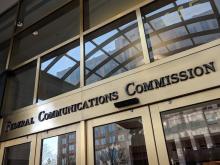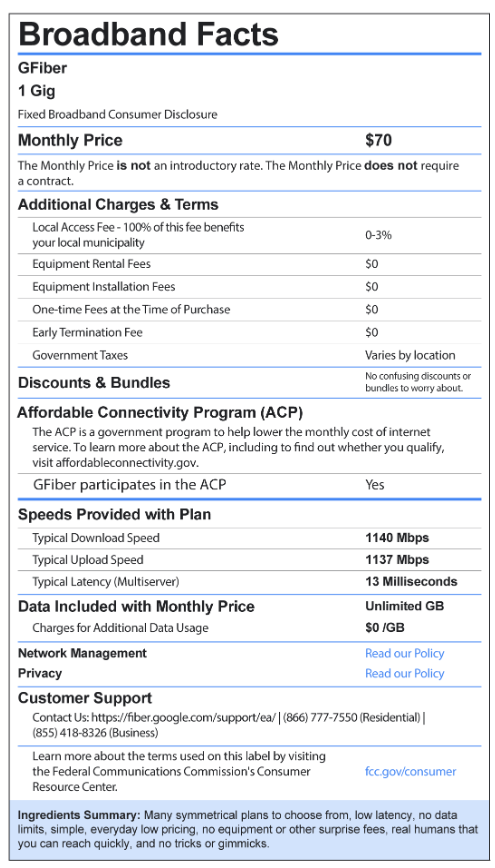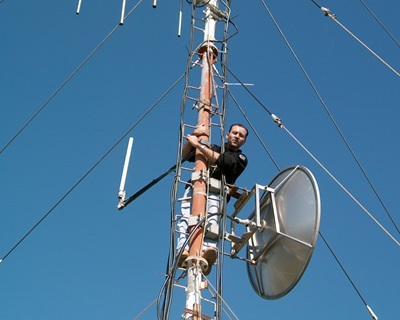
Fast, affordable Internet access for all.

The Federal Communication Commission (FCC) recently published rules for its broadband nutrition label provides a partial victory for Internet subscribers and a potential marketing advantage for fiber providers – but may pose a challenge for wireless Internet service providers.
Though the new rules were finalized in October, Internet Service Providers (ISPs) have until April 10, 2024 to publish their broadband labels, though providers with 100,000 or fewer subscriber lines have until October 10, 2024.
Just like the label on the back of packaged food in grocery stores helps shoppers understand the nutritional value of the food they are buying, the broadband label requires ISPs to disclose their broadband pricing and service information (at the point of sale) to help potential subscribers make informed decisions about the service they are signing up to get.
Transparency on Display
Though the label is just another red-tape requirement for some providers, others see it as an opportunity to show off the quality of their services.

Google Fiber, for example, published via social media and its blog a preliminary version of its own broadband consumer label, just days after the final rule was published, and six months before its deadline.
In a post titled “Is your internet high fiber?,” Ariane Schaffer, the company's Government Affairs & Public Policy Manager, wrote about how the broadband nutrition labels are "a great idea," adding "we didn’t think that Google Fiber customers should have to wait for that clarity. As of today, GFiber is launching nutrition labels for our residential 1 Gig, 2 Gig, 5 Gig, and 8 Gig products — some of the first to roll out anywhere.”
Schaffer told ILSR, “we think that transparency is the right thing for the customer. It should be easy to understand what you are paying and what you are getting for that price.”
The label helps Google show off its consistent speeds and straightforward pricing structure, especially when compared with large monopoly providers known for making it difficult, if not impossible, for subscribers to figure out exactly how much they can expect to pay month-to-month.
Planet Networks, an ISP serving just over 6,000 subscribers in New Jersey, Pennsylvania, and New York, didn’t wait until the final requirements were published to showcase its broadband nutrition label over a year ago. The ISP posted the label on social media in addition to publishing it at the point of sale, the minimum requirement.
Planet Networks CEO Robert Boyle told ILSR that putting the label together was simple:
“We don't play games with pricing and we overprovision everything to ensure customers always get what they are paying for.”
He believes Planet Network’s straightforward and honest pricing, exhibited on the label, gives the provider a market advantage, which is why the company shared it on its social media platforms. “I think greater transparency is going to help us compete against the cable company when they advertise one price, but actually bill significantly more after all their made up fees that they disguise as government taxes and surcharges,” Boyle said. “There is no sales tax nor other government taxes in any jurisdiction where we do business.”
Boyle also mentioned that Planet Networks would eventually publish the label on monthly bills – something advocates fought hard for but that didn’t make it into the final ruling.
A Challenge for WISPs
While the label is a great opportunity for fiber providers to show off their speeds, some wireless Internet service providers (WISPs) are concerned that meeting the requirements will be more difficult for them. WISPs with straightforward and transparent pricing structures shouldn’t have an issue when it comes to reporting cost of service. The challenge is reporting performance metrics.

Matt Larson, CEO of Vistabeam, a wireless provider serving over 8,500 subscribers across Colorado, Kansas, Nebraska, & Wyoming, told ILSR that “it’s almost impossible to put out performance metrics that will be consistent across the board because network conditions change constantly.” Speed and latency, he said, vary greatly depending on what time of day it is and how much traffic there is.
Larson worries that the label will create unrealistic expectations by incentivizing providers to overstate their services. He also emphasized that it leaves out other important information that could help potential subscribers make decisions, such as the level of competition in a given area, what kind of company is offering the service, and the provider’s responsiveness to service outages and billing concerns.
Bringing Transparency to Market
Ideally, no ISP would try to lure subscribers into purchasing broadband service through complex pricing structures or other deceptive sales tactics. And while the new labels may be a headache for some providers, the idea behind requiring them is rooted in enabling the transparency true free markets require, and to establish mechanisms that are in the best interest of subscribers.
Although, it should also be noted that a number of public interest groups agree the label requirements don’t go far enough, as noted by Free Press policy director Josh Stager. Stager points out how the FCC opted not to require the label be put on the monthly bill (only at the point of sale), adding that the new rules still allow providers to hide the label from subscribers who are not aware that the label even exists.
Still, we hope to see the new labels nudge providers away from opaque pricing and sneaky deals that are actually a huge part of the reason why big cable and telecom companies are among the most hated companies in the nation.
Header image of FCC building courtesy of Rob Pegoraro, Attribution-NonCommercial-ShareAlike 2.0 Generic
Inline image of network engineer on wireless network tower courtesy of Wikimedia Commons, Attribution-ShareAlike 3.0 Unported
